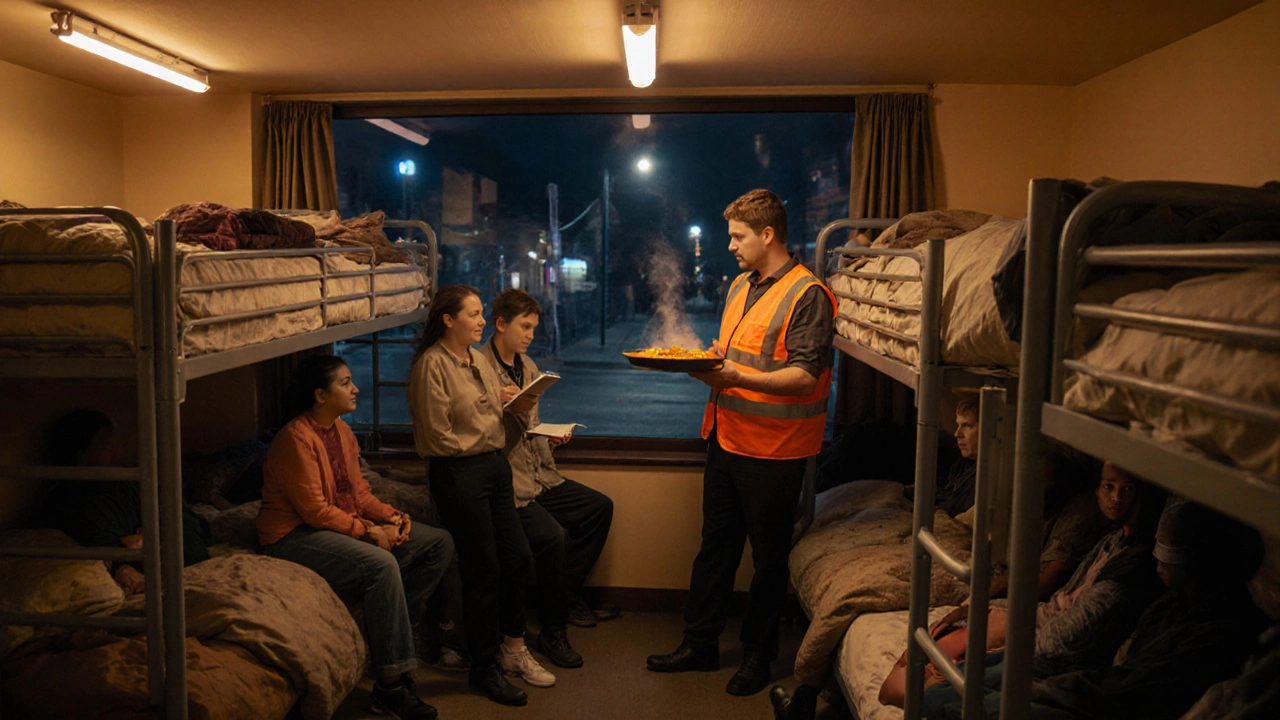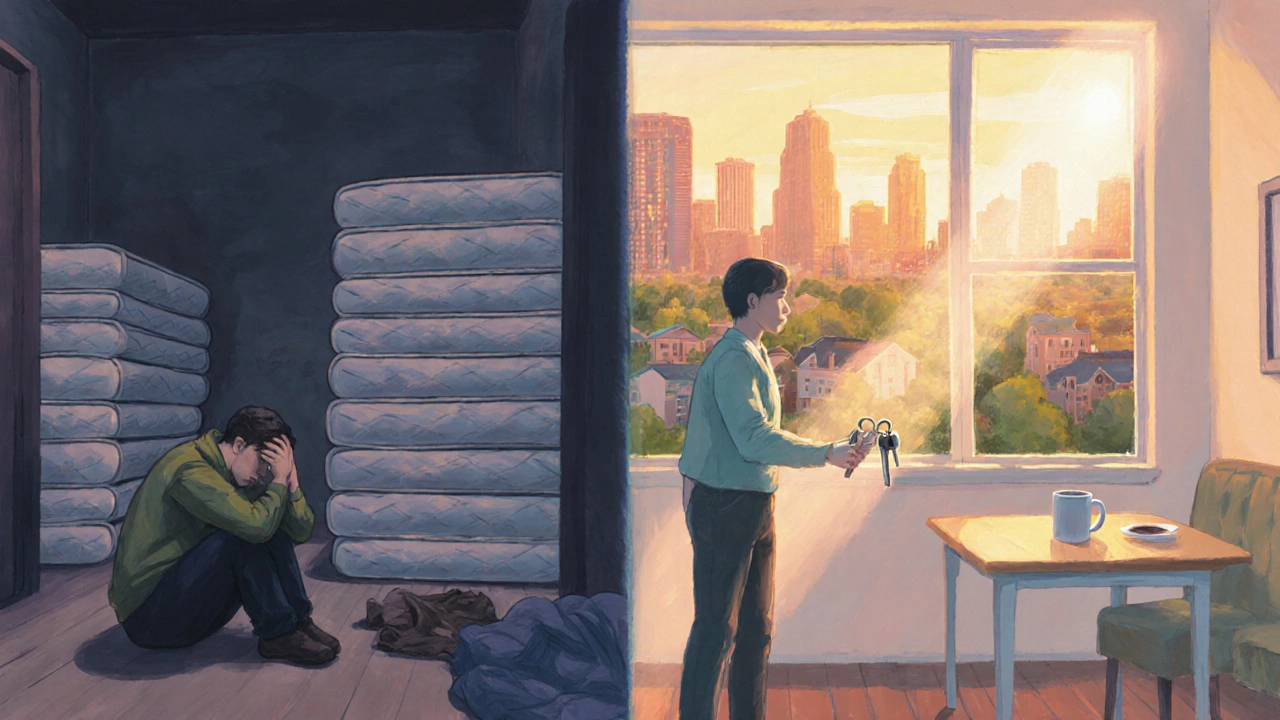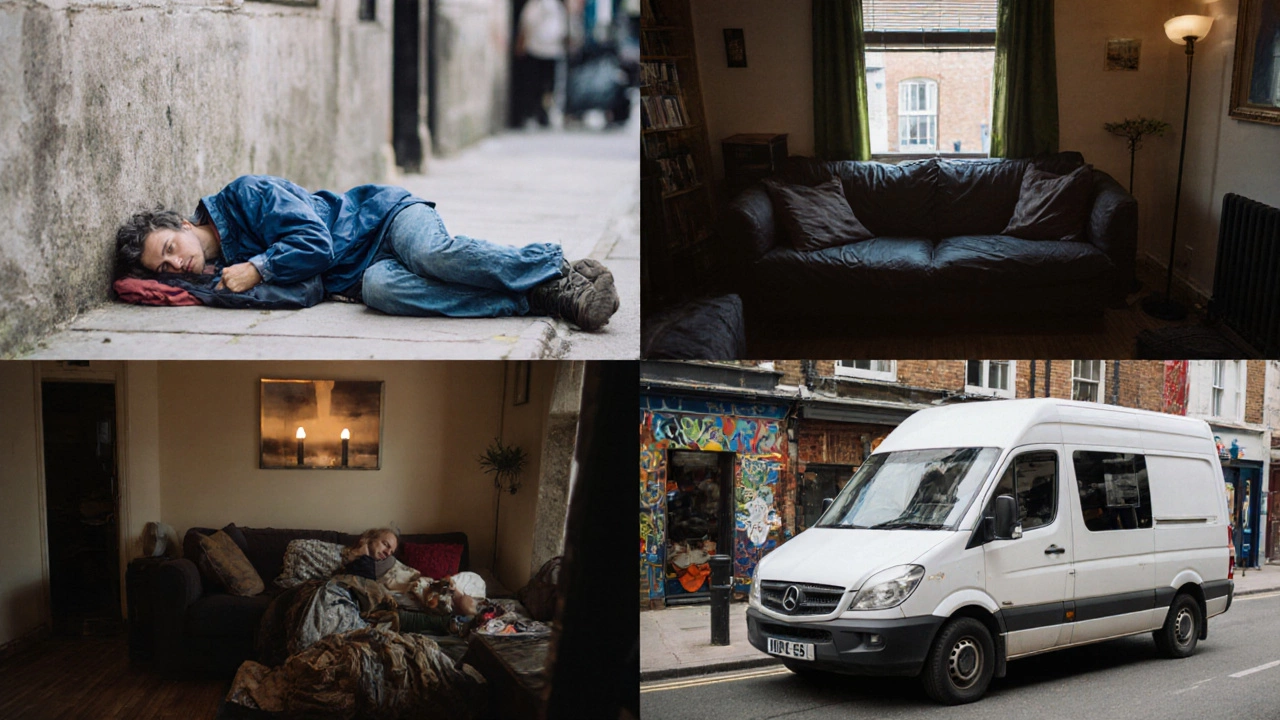Homelessness Distribution Calculator
Calculate UK Homelessness Distribution
Enter the total number of homeless people to see the breakdown by living arrangement based on 2024 UK statistics.
Breakdown of Homelessness Distribution
Based on 2024 UK statistics, here's how homeless people would be distributed:
Understanding where the homeless population actually lives is the first step in tackling the crisis. Across the United Kingdom, people experiencing homelessness don’t all end up on the streets - many find refuge in shelters, cars, temporary units or even hidden encampments. This guide breaks down the most common living situations, backs them with the latest data, and shows what it means for policymakers, charities and anyone who wants to help.
What "homeless" really means in the UK
In official terms, homelessness is defined as "the condition of lacking a stable, permanent residence". The definition covers four main categories:
- People sleeping rough (on streets, in parks or public spaces)
- Those staying in temporary accommodations like hostels or emergency shelters
- Individuals living in insecure or unsuitable housing (e.g., couch‑surfing, unsafe rooms)
- People residing in a vehicle, caravan or other mobile unit
Each category has its own challenges and support pathways, which is why data is usually split by "living arrangement" rather than a single blanket figure.

Latest UK figures - where do most people sleep?
According to the Ministry of Housing, Communities & Local Government’s 2024 Annual Homelessness Report, the breakdown of the homeless population at any given night looks roughly like this:
| Living arrangement | % of total homeless people | Typical duration (weeks) | Key support services |
|---|---|---|---|
| Emergency shelter | 42% | 2‑4 | Meals, counseling, referral to housing programs |
| Rough sleeping (streets, parks, under bridges) | 31% | 4‑12+ | Outreach teams, temporary units, health services |
| Living in a vehicle (car, van, caravan) | 12% | 1‑6 | Legal advice, parking permits, temporary accommodation links |
| Transitional or temporary housing (hostels, supported lodgings) | 9% | 6‑24 | Housing First pathways, employment support |
| Hidden arrangements (couch‑surfing, unsafe rooms) | 6% | Variable | Early intervention, social services referrals |
Emergency shelters remain the single largest category, but rough sleepers still make up almost a third of the total. Vehicles are a growing segment, especially in cities where housing costs push people onto the road.
Regional differences - a closer look at England, Scotland, Wales and Northern Ireland
While the national averages give a good snapshot, each nation within the UK shows a slightly different picture.
- England - 68% of rough sleepers are concentrated in London, the South East and the West Midlands. Shelters are most plentiful in these same regions.
- Scotland - Rough sleeping accounts for 24% of the homeless count, with a higher proportion staying in hostels due to a stronger public‑funded system.
- Wales - Recent data shows 28% in shelters, 22% rough sleeping, and a notable 15% living in vehicles, reflecting limited rural accommodation.
- Northern Ireland - Shelters dominate at 55%, with rough sleepers at 18%.
These variations matter because funding, policy approaches and charity focus differ by region.

Why the split matters for charities and local authorities
Understanding the exact living arrangement helps organisations allocate resources efficiently.
- Shelters: Need funding for bed space, staff, and on‑site health services. Partnerships with local hospitals reduce emergency visits.
- Rough sleepers: Require outreach teams, mobile hygiene units, and rapid‑response temporary housing. Studies in Bristol show that a single outreach worker can transition 3‑4 individuals per month.
- Vehicle dwellers: Benefit from legal advice on parking rights and quick‑step temporary accommodation schemes.
- Transitional housing: Requires longer‑term case management, job training and mental‑health support.
When data is granular, donors can see where their money makes the biggest impact, and councils can meet statutory targets for reducing rough sleeping.
Key policies shaping where homeless people live
Two major approaches dominate UK practice:
- Housing First - Provides immediate, permanent housing without pre‑conditions, then layers support. Trials in Manchester and Glasgow have cut rough sleeping by up to 40%.
- Emergency shelter funding - Guarantees a night‑by‑night safety net but can create dependency if not linked to long‑term solutions.
Both policies influence the distribution of living arrangements. Cities that have embraced Housing First see a higher share in transitional or permanent housing and a lower share of street sleeping.

Practical ways you can help from the ground up
Whether you’re a volunteer, a donor, or just a concerned citizen, there are concrete steps you can take:
- Volunteer with a local charity that runs night shelters - even a few hours a week can free up staff for outreach.
- Donate items that shelters need most: blankets, reusable toiletries, and non‑perishable food. A single blanket can keep a person warm for an entire winter night.
- Support advocacy groups pushing for more Housing First schemes. Signing petitions or attending council meetings adds pressure for systemic change.
- Offer a spare room or a couch for short‑term stays - many hidden homeless people rely on informal networks before they ever enter a shelter.
Every action shifts the balance a little more toward stable housing.
Frequently Asked Questions
How many people are currently homeless in the UK?
The 2024 report estimates around 280,000 people experience some form of homelessness on any given night across the United Kingdom.
What defines ‘rough sleeping’?
Rough sleeping means sleeping outdoors in public places - streets, parks, under bridges, or in cars - without any form of shelter or secure accommodation.
Are shelters free to use?
Yes, emergency shelters are provided at no cost. They cover a bed, meals, and often basic health services, but they are meant for short‑term stays.
What is the Housing First model?
Housing First places people directly into permanent housing without requiring them to meet conditions like sobriety or employment first. Support services are added afterwards.
How can I find a local shelter near me?
Most councils publish a list of emergency shelters on their website. You can also call the national helpline 0800 091 2077 to get the nearest location.
